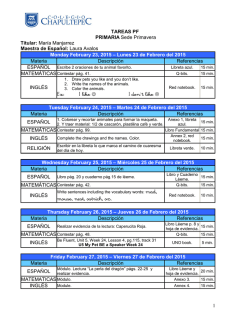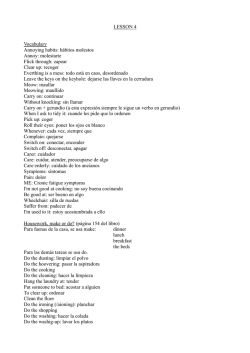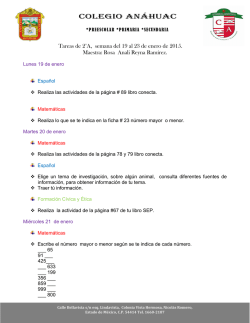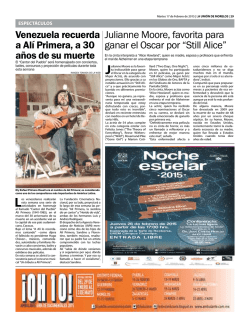
HABLA INGLÉS COMO UN NATIVO
HABLA INGLÉS COMO UN NATIVO EJERCICIOS Y GRAMÁTICA PARA UN INGLÉS FLUIDO Autor: Euan Dunn Coordinación de proyecto: Adriana Moody y Rubén Palomero Edición: Augusto Hernández, Lorena Fernández y Adriana Moody Voces: Euan Dunn e Irene Lapaz Sonido: Daniel Escudero, Ignacio Carvajal, Juan José Durán y Juan García Escribano. Diseño y maquetación: ZAC diseño gráfico ISBN: 978-84-16094-43-1 Dep. Legal: M-4114-2015 Propiedad de la presente edición: © 2015 Vaughan Systems CAN YOU BEAT THE NATIVE SPEAKER? Thank you … Rubén and Adriana for overseeing the project, Augusto for all your editing work, everyone at ZAC for organizing the layout and design, Irene and everyone in the recording team for setting up the audio sections, And a special “thank you” to Lorena for translating everything (and for putting up with me in general while I finished each book…). I really appreciate everyone’s effort, Euan CONTENTS How much do you really want it? ................................................................................................................................... 9 La Estructura del Libro ........................................................................................................................................................10 The Rules – Las Reglas.......................................................................................................................................................11 Exercises 001 002 003 004 005 006 007 008 009 010 011 012 013 014 015 016 017 018 019 020 021 022 023 024 025 026 027 028 029 030 031 Verb “to be” .............................................................................................................................................................................15 Prepositions of place ..........................................................................................................................................................20 All, both, neither, none........................................................................................................................................................24 “This, that, these, those” / Numbers 1 - 100 ............................................................................................................28 Present Continuous .............................................................................................................................................................32 Prepositions of Motion .......................................................................................................................................................36 There is / are [Introduction] ............................................................................................................................................40 There is / are [Questions and Negatives]...................................................................................................................44 Numbers [continued] and American Times .............................................................................................................48 Who, What, Where, When, Why…? ................................................................................................................................52 Review [Repaso] .....................................................................................................................................................................56 Can and U.K. Times .............................................................................................................................................................61 Days / Dates............................................................................................................................................................................65 Object Pronouns ...................................................................................................................................................................70 Phrasal Verbs 1 / Same, different .................................................................................................................................74 Comparatives - Adjectives...............................................................................................................................................79 Saxon Genitive / Possessive Adjectives and Pronouns .....................................................................................84 Present Simple - Third person “-s / Adverbs of Frequency and Time........................................................89 Present Simple Questions and Negatives.................................................................................................................94 Prepositions of time / Reflexive Pronouns / “Alone”...........................................................................................98 Mastering the Interrogative / Which / Whose / To go verb-ing.................................................................103 Review [Repaso] ..................................................................................................................................................................108 How many …?, How much …? Intro. / Hundred(s) .............................................................................................113 Someone, nobody, anything, everywhere etc. / Else.........................................................................................117 “Quantity words” ................................................................................................................................................................121 Phrasal Verbs 2 / To like, to enjoy / “to be left” .................................................................................................126 To get + Adj / To make (someone) Adj / verb......................................................................................................131 More, fewer, less / (not) as many as, (not) as much as ...................................................................................136 To want, would like / To agree / To verb, for gerund.........................................................................................140 Future “to be going to + verb” ......................................................................................................................................145 So, neither / Expressions 1 ............................................................................................................................................150 032 033 034 035 036 037 038 039 040 041 042 043 044 045 046 047 048 049 050 051 052 053 054 055 To take (time) / To last (time) / How long …? .....................................................................................................155 Review [Repaso] ..................................................................................................................................................................159 Superlatives / Too, (not) enough................................................................................................................................164 And, But, Because, So / So, such ................................................................................................................................169 Might, May, Should, Have to, Must .............................................................................................................................174 (Not) enough / Too much, many / So much, many / To take (quantity) ................................................179 Phrasal verbs 3, Expressions 2....................................................................................................................................184 Will / Future conditional (if, unless, as soon as)..................................................................................................189 Adverbs / How + adjective?, How + adverb? etc. ................................................................................................194 Still, not anymore, no longer ........................................................................................................................................199 ‘Saber hacer’ / Suggest, recommend, demand, insist / Say, tell .................................................................204 Past Simple (Regular verbs) / was, were / there was, there were ..............................................................209 Review [Repaso] ..................................................................................................................................................................214 Past simple - Irregular verbs 1 .....................................................................................................................................219 Do, make ................................................................................................................................................................................224 Past simple - Irregular verbs 2 ....................................................................................................................................229 Past simple - Irregular verbs 3 / “to be” just about to .....................................................................................234 Phrasal verbs 4, Expressions 3 ...................................................................................................................................239 Past simple - Irregular verbs 4 / “to be” able to / before, after ..................................................................244 As well as / Despite / Due to .......................................................................................................................................249 Past continuous - Past simple / There is, are (review) ....................................................................................254 Must (supposition) / Shall, May, Could ...................................................................................................................259 Present Perfect (Regular verbs) / Verb “to be” ...................................................................................................264 Review [Repaso] ..................................................................................................................................................................269 New Vocabulary .................................................................................................................................................................... 274 How much do you really want it? Mucha gente dice que quiere aprender inglés, pero realmente, ¿cuánto lo desean? Si eres de los que piensa: “no está mal cometer errores siempre y cuando la gente me entienda”, no malgastes tu tiempo, este libro no es para ti. Si eres de los que piensa que pasar horas memorizando frases de turismo es el mejor modo de mejorar tu inglés, ponlo de nuevo en la estantería. Pero si tienes el deseo y la determinación de terminar por completo con la torpeza que distingue a los no nativos con nivel medio de los que tienen un alto nivel lingüístico, entonces este es tu libro. Aprender un idioma siendo adulto requiere de mucho trabajo y de un gran esfuerzo. Algunos intentarán eludir su responsabilidad por haber fracasado en su aprendizaje diciendo: “es que no se me dan bien los idiomas”. Nada más lejos de la realidad. “No ser bueno” en los idiomas no justifica la falta de progreso, es una mera consecuencia de no haber trabajado lo suficiente o de no haberlo hecho utilizando el método adecuado. Este último punto es clave, por eso necesitas un método que esté tan bien estructurado que todo el esfuerzo que hagas se transforme en progreso cuantificable. El método de este libro es repetitivo, pero no mecánico. Si memorizas listas de verbos como un robot, vas a hablar como tal. Si sólo aprendes vocabulario, continuarás siempre pensando en español antes de decir cualquier cosa en inglés. Este libro es diferente, y por eso si te entregas a él, triunfarás. Enseño a gran cantidad de gente “ocupada”, pero siempre les digo que si quieren aprender van a tener que estar “más ocupados aún”. Aprender inglés tiene que llegar a ser parte de la rutina diaria, sin descansos ni vacaciones. Algunos tendrán que hacer algún que otro sacrificio como dejar de ver algún programa de televisión, comer más rápido, renunciar al café de media mañana o incluso levantarse media hora antes cada día. El inglés tiene que convertirse en una prioridad. No hay otra forma de progresar. Así que la pregunta es, ¿cuánto quieres aprender realmente? La respuesta no es: “quiero aprender mucho”, o: “realmente necesito el inglés para mi trabajo”, o incluso: “estoy desesperado por aprender inglés”. La verdadera respuesta no proviene de una frase, sino de la cantidad de tiempo que pases entrenándote cada día. Esa será la única prueba de cuánto lo quieres realmente. Cada minuto que pases frente al televisor por matar el tiempo, estarás contestando a mi pregunta. Cada minuto que te tumbes en la cama sintiendo pereza para levantarte y estudiar, estarás contestando a mi pregunta. Pero del mismo modo, cada minuto que pases practicando con este libro, incluso cuando hayas tenido un día duro y lo único que quieras sea tirarte en el sofá y desconectar, estarás contestando a mi pregunta. Ésos son los minutos que cuentan. Every “perfect” English speaker was a beginner who didn’t give up. (‘Todo el que habla inglés “perfectamente”, fue un principiante que no se rindió.’) Euan Dunn - Autumn 2014 HABLA INGLÉS COMO UN NATIVO · 9 La estructura del libro Esta es la primera vez que una serie de dos libros abarca todos los puntos gramaticales más importantes de la lengua inglesa. Estos libros son diferentes de cualquier otro que hayas visto antes porque están diseñados no solo para hacerte hablar sino también para hacerte pensar en inglés. Todos los ejercicios son en inglés, no encontrarás ejercicios de traducciones. Las traducciones son útiles en tu aprendizaje, pero este libro se centra en la agilidad lingüística. Muchos estudiantes pueden traducir un texto rápidamente, pero carecen de la agilidad necesaria para usar el lenguaje de forma fluida en la vida real. Todo estudiante debería empezar por el Book 1. Los ejercicios de agilidad son mucho más complicados que los de traducción. Aunque te consideres un estudiante “advanced”, estos libros te permitirán corregir los puntos débiles de tu agilidad lingüística. Los ejercicios se centran en las estructuras más usadas por los angloparlantes. Todo aquello que necesitas para mejorar tu nivel de inglés está incluido en este libro: ejercicios gramaticales, teoría gramatical, vocabulario y audio. Ejercicios cronometrados Los ejercicios se realizan en inglés y bajo la presión del cronómetro con el fin de recrear la propia presión que puedas sentir al hablar inglés en la vida real. Como verás, hay unas casillas al lado de cada ejercicio en las que podrás marcar tus errores. De este modo, podrás comprobar tu progreso después de cada intento. El objetivo es completar el ejercicio a la misma velocidad que lo haría un nativo. Teoría Gramatical Cada ejercicio viene precedido por una corta pero precisa explicación gramatical sobre el punto que se trata. No necesitas mucha teoría, sino prácticas concretas que es lo que este libro te va a proporcionar. En el Book 1 las explicaciones gramaticales son en español, sin embargo en el Book 2, gradualmente irán apareciendo en inglés hasta que al final del libro serán por completo en inglés. Vocabulario Una de las claves de este libro es que nunca encontrarás una palabra o un punto gramatical que no haya sido definida o explicada con anterioridad en el libro. Antes de abordar cada ejercicio, encontrarás la sección “new vocabulary” correspondiente. En el Book 1 el vocabulario nuevo se presenta en tablas convencionales, pero en el Book 2 cada sección de vocabulario incluye definiciones sencillas en inglés para reforzar el principio de aprender inglés en inglés. Audio Como es habitual en un libro Vaughan, cada ejercicio y cada lista de vocabulario vienen acompañados de un audio descargable con el fin de ayudarte a mejorar tu pronunciación y escuchar el ritmo de un nativo hablando a una velocidad normal. Ahora lee las reglas y a por ello. 10 · HABLA INGLÉS COMO UN NATIVO HABLA INGLÉS COMO UN NATIVO 041 Still, not anymore, no longer Grammar Explanation Los estudiantes españoles cometen errores con estas palabras continuamente. A menudo confunden “yet” y “already”. Intentar aprender las definiciones directas de estas palabras es un error. ‘Todavía’ por ejemplo, puede ser el significado de ambos “still” y “yet”, pero en inglés estas dos palabras tienen diferentes significados. Por esta razón, vas a practicar con la definición en inglés de las palabras. En vez de practicar con “still”, “not anymore”, “yet” and “already” todas juntas desde el principio, vamos a separarlas en dos pares de opuestos: “still - not anymore” / “yet - already”. Aquí nos concentramos en “still” y “not anymore”. La clave para usar estas palabras correctamente en inglés es darse cuenta de la continuidad. Puedes ver por los ejemplos de abajo que es posible rehacer las preguntas y oraciones con “still” usando el verbo en inglés “to continue”. r “Still” es para interrogativas y afirmativas sobre continuidad. Posición: Ponlo antes del verbo principal pero después del verbo “to be” (igual que un adverbio de frecuencia). Does he still work there? Yes, he still works there. es igual que Does he continue to work there? Yes, he continues to work there. r “Not… anymore” y “no longer” son para negativas. Posición: Pon “not” con el verbo auxiliar y “anymore” al final. No, he doesn’t work there anymore. No, he doesn’t continue to work there. Posición: Pon “no longer” antes del verbo principal o después del verbo “to be”. No, he no longer works there. No, he doesn’t continue to work there. Recuerda: “still” es para preguntas sobre continuidad. Céntrate en ese significado más que en las definiciones en castellano. Si la pregunta utiliza “still”, la respuesta tiene que usar “still” (afirmativa) o “not anymore” / “no longer” (negativa). (Los nativos pueden contestar a veces una pregunta de “still” con una frase diferente, pero hasta que no domines los conceptos básicos, guíate por las reglas anteriores). HABLA INGLÉS COMO UN NATIVO · 199 Los principios se aplican del mismo modo a “there is / are”, (“still” va después del verbo “to be”). “There is”/ “are” – ‘Hay’ Is there still a lot of money? Yes, there’s still some money. No, there isn’t any money anymore. No, there’s no longer any money. Puedes usar “still” con cualquier tiempo: Are they still travelling? Will he still come if you stay? Are you still going to do it? Yes, they’re still travelling. Yes, he’ll still come if you stay. No, I’m not going to do it anymore. Estas son las reglas básicas para comenzar, si las sigues, siempre lo usarás correctamente. Sin embargo, después verás que “no longer” y “not anymore” pueden ser usados en ciertas preguntas. Can you beat the native speaker? Apréndete el vocabulario (página 291) y lee el ejemplo antes de intentar batir al nativo. En este ejercicio vas a rehacer muchas oraciones y otro ejercicio de “Mastering the Interrogative”. Cada sección es suficientemente auto-explicativa como puedes ver en este ejemplo de la primera sección: Example: Rehaz las siguientes oraciones con “still” y “not anymore”. They don’t continue to eat meat. They don’t eat meat anymore. Es una frase negativa de continuidad, así que usa “not…anymore”: “They don’t eat…anymore”. Sólo ten cuidado con el verbo “to be”: Ask me if she continues to be the boss. Is she still the boss? Recuerda no utilizar “do / does” con el verbo “to be”. Esta es la teoría, demuéstrame que puedes ponerla en práctica como un nativo. 200 · HABLA INGLÉS COMO UN NATIVO Velocidad normal de un nativo (Normal Native Speed) 5 min (0 mistakes) 41 AUDIO Tapa todas las respuestas y pon en marcha el cronómetro Mistakes Rehaz las siguientes oraciones con “still” o “not anymore”. 1 2 3 4 5 Do they continue to spend more than they earn? Do they still spend more than they earn? He continues to want to be the best. He still wants to be the best. She isn’t continuing to talk to them. She isn’t talking to them anymore. Are they continuing to sell those? Are they still selling those? I don’t continue to know them. I don’t know them anymore. You continue to read it nowadays. You still read it nowadays. PAUSA Contesta las siguientes preguntas utilizando pronombres sujetos y “still” o “no longer”. REANUDA Mistakes 1 2 3 4 5 Is Zapatero still the president? No, he’s no longer the president. Are France and Germany still in Europe? Yes, they’re still in Europe. Do international business people still use telegrams? No, they no longer use telegrams. Do people still ride horses to work in Madrid? No, they no longer ride horses to work in Madrid. Is London still the biggest city in the world? No, it’s no longer the biggest city in the world. Are you still answering these questions? Yes, I’m still answering these questions. HABLA INGLÉS COMO UN NATIVO · 201 Contesta las siguientes preguntas utilizando pronombres sujetos y “still” o “no longer”. Mistakes 1 2 3 4 5 Is the U.S.A. still the richest country in the world? Yes, it’s still the richest country in the world. Are there still a lot of bears in Germany? No, there are no longer a lot of bears in Germany. Does the U.S.A. still use the dollar? Yes, it still uses the dollar. Is there still an obesity problem in rich countries? Yes, there’s still an obesity problem in rich countries. PAUSA Dominando el interrogativo. Formula las preguntas lógicas que irían antes de las siguientes respuestas. REANUDA Mistakes 1 2 3 4 5 No, I no longer want to work there. Do you still want to work there? No, he doesn’t go cycling anymore Does he still go cycling? Yes, there are still going to be a lot of things to buy Are there still going to be a lot of things to buy? No, they’re no longer going to finish the project on time. Are they still going to finish the project on time? No, they aren’t watching cartoons anymore. Are they still watching cartoons? Yes, she still meets her old school friends. Does she still meet her old school friends? Yes, he still has tantrums sometimes. Does he still have tantrums sometimes? Formula las siguientes preguntas y contéstalas. REANUDA Ask me if Britain continues to control North America. Does Britain still control North America? No, Britain doesn’t control North America anymore. Ask me if Real Madrid continue to have a lot of good players. Do Real Madrid still have a lot of good players? (Plural or sing. for teams) Yes, Real Madrid still have a lot of good players. 202 · HABLA INGLÉS COMO UN NATIVO PAUSA Mistakes 1 2 3 4 5 Mistakes Formula las siguientes preguntas y contéstalas. 1 2 3 4 5 Ask me if sailing continues to be the fastest way to get to New York. Is sailing still the fastest way to get to New York? No, sailing isn’t the fastest way to get to New York anymore. Ask me if France continues to have a royal family. Does France still have a royal family? No, France doesn’t have a royal family anymore. Ask me if there continues to be an international space station. Is there still an international space station? Yes, there’s still an international space station. Ask me if people normally continue to go hunting for their dinner. Do people still normally go hunting for their dinner? No, people don’t normally go hunting for their dinner anymore. Ask me if there continues to be a lot of pollution in modern cities. Is there still a lot of pollution in modern cities? Yes, there’s still a lot of pollution in modern cities. Total Mistakes Para el reloj y anota tu tiempo en la siguiente tabla Times 5 min Normal Native Speed (Keyboard - Teclado) 5 min 45 s Pen (Bolígrafo) 7 min 30 s Feather (Pluma) Normal Native Speed Time (Mistakes) Time 1 Time 2 Time 3 Time 4 Time 5 5 min (0) HABLA INGLÉS COMO UN NATIVO · 203
© Copyright 2025



